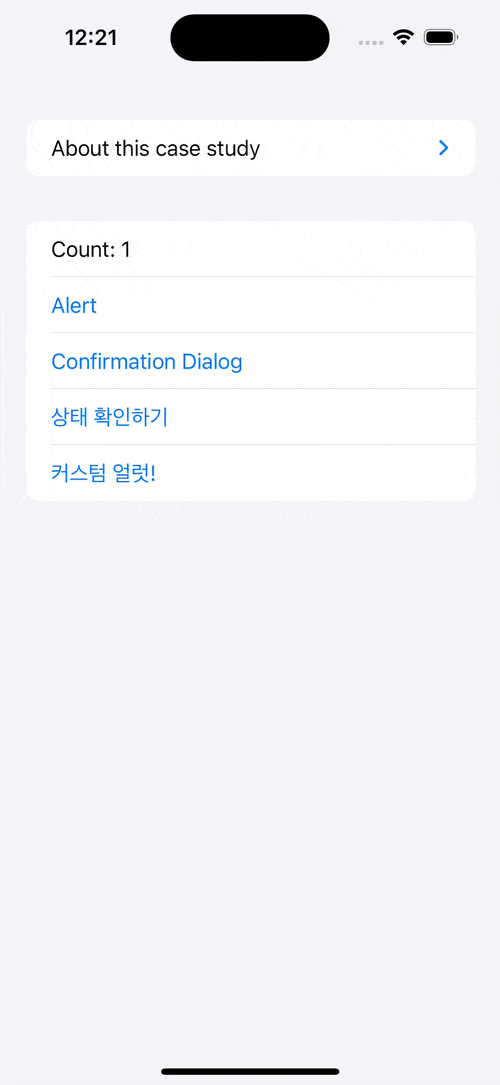전체 코드
import ComposableArchitecture
import SwiftUI
private let readMe = """
This demonstrates how to best handle alerts and confirmation dialogs in the Composable \
Architecture.
The library comes with two types, `AlertState` and `ConfirmationDialogState`, which are data \
descriptions of the state and actions of an alert or dialog. These types can be constructed in \
reducers to control whether or not an alert or confirmation dialog is displayed, and \
corresponding view modifiers, `alert(_:)` and `confirmationDialog(_:)`, can be handed bindings \
to a store focused on an alert or dialog domain so that the alert or dialog can be displayed in \
the view.
The benefit of using these types is that you can get full test coverage on how a user interacts \
with alerts and dialogs in your application
"""
@Reducer
struct AlertAndConfirmationDialog {
@ObservableState
struct State {
@Presents var alert: AlertState<Action.Alert>?
@Presents var confirmationDialo: ConfirmationDialogState<Action.ConfirmationDialog>?
@Presents var customAlert: CustomAlert?
var count = 0
}
enum Action: Equatable {
case alert(PresentationAction<Alert>)
case alertButtonTapped
case confirmationDialog(PresentationAction<ConfirmationDialog>)
case confirmationDialogButtonTapped
case customAlertTapped
case customAlert(PresentationAction<CustomAlert>)
case confirmationStateOfAlertAndDialog
@CasePathable
enum Alert {
case incrementButtonTapped
}
@CasePathable
enum ConfirmationDialog {
case incrementButtonTapped
case decrementButtonTapped
}
@CasePathable
enum CustomAlert{
case closeTapped
}
}
var body: some Reducer<State, Action> {
Reduce{ state, action in
switch action {
case .customAlertTapped:
state.customAlert = CustomAlert()
return .none
case .customAlert(.presented(.closeTapped)):
return .none
case .customAlert:
return .none
case .confirmationStateOfAlertAndDialog :
print("alert: \(state.alert == nil), dialog: \(state.confirmationDialo == nil)")
return .none
case .alert(.presented(.incrementButtonTapped)),
.confirmationDialog(.presented(.incrementButtonTapped))
:
state.alert = AlertState{
TextState("Incremented")
}
state.count += 1
return .none
case .alert:
return .none
case .alertButtonTapped:
state.alert = AlertState {
TextState("Alert!")
} actions: {
ButtonState(action: .incrementButtonTapped) {
TextState("Increment")
}
} message: {
TextState("This is an Alert")
}
return .none
case .confirmationDialog(.presented(.decrementButtonTapped)) :
state.alert = AlertState { TextState("Decremented!")}
state.count -= 1
return .none
case .confirmationDialog(.presented(.incrementButtonTapped)) :
state.alert = AlertState { TextState("increment!!")}
state.count += 1
return .none
case .confirmationDialog:
return .none
case .confirmationDialogButtonTapped:
state.confirmationDialo = ConfirmationDialogState {
TextState("Confirmnation dialog")
} actions: {
ButtonState(role: .cancel) {
TextState("Cancel")
}
ButtonState(action: .decrementButtonTapped) {
TextState("DecrementButtonTapped")
}
ButtonState(action: .incrementButtonTapped) {
TextState("incrementButtonTapped")
}
}message: {
TextState("This is a confirmnation Dialog.")
}
return .none
}
}
.ifLet(\.$alert, action: \.alert)
.ifLet(\.$confirmationDialo, action: \.confirmationDialog)
// .ifLet(\.$customAlert, action: \.confirmationDialog)
}
}
struct AlertAndConfirmationDialogView: View {
@Bindable var store: StoreOf<AlertAndConfirmationDialog>
var body: some View {
Form {
Section {
AboutView(readMe: readMe)
}
Text("Count: \(store.count)")
Button("Alert") { store.send(.alertButtonTapped) }
Button("Confirmation Dialog") { store.send(.confirmationDialogButtonTapped) }
Button("상태 확인하기") {
store.send(.confirmationStateOfAlertAndDialog)
}
Button("커스텀 얼럿!") {
store.send(.customAlertTapped)
}
Section {
if let alert = store.state.customAlert {
alert
}
}
}
.navigationTitle("Alerts & Dialogs")
.alert($store.scope(state: \.alert, action: \.alert))
.confirmationDialog($store.scope(state: \.confirmationDialo, action: \.confirmationDialog))
}
}
struct CustomAlert: View {
var body: some View {
VStack{
Button("Close") {
}
}
}
}
- @Presents
State에 다음과 같은 case 들이 존재합니다. @Presents var alert, @Presents var confirmationDialog 이 앞에 @Presents들은 무엇일까 고민해봤습니다. Depth에는 다음과 같이 적혔습니다. 봐도 모르겠네요. Alert와 Dialog 가 Presents될 수 있게 만들어주는 Macro같습니다.
/// Wraps a property with ``PresentationState`` and observes it.
///
/// Use this macro instead of ``PresentationState`` when you adopt the ``ObservableState()``
/// macro, which is incompatible with property wrappers like ``PresentationState``.
- @CasePathable
CasePathable의 매크로를 작성함으로서, Alert와 Dialog의 상세 동작을 적어줍니다. 또한 Reduce에서 분기를 칠 수 있게, Action 에 case 를caseconfirmationDialog(PresentationAction<ConfirmationDialog>) 과 같이 작성합니다. 이렇게 된다면, reduce 에서 Action을 분기할 수 있습니다. 관련 문서에는 다음과 같이 적혀 있습니다.
/// Defines and implements conformance of the CasePathable protocol.
///
/// This macro conforms the type to the ``CasePathable`` protocol, and adds ``CaseKeyPath``
/// support for all its cases.
///
/// For example, the following code applies the `CasePathable` macro to the type `UserAction`:
///
/// ```swift
/// @CasePathable
/// enum UserAction {
/// case home(HomeAction)
/// case settings(SettingsAction)
/// }
/// ```
///
/// This macro application extends the type with the ability to derive a case key paths from each
/// of its cases using a familiar key path expression:
///
/// ```swift
/// // Case key paths can be inferred using the same name as the case:
/// _: CaseKeyPath<UserAction, HomeAction> = \.home
/// _: CaseKeyPath<UserAction, SettingsAction> = \.settings
///
/// // Or they can be fully qualified under the type's `Cases`:
/// \UserAction.Cases.home // CasePath<UserAction, HomeAction>
/// \UserAction.Cases.settings // CasePath<UserAction, SettingsAction>
/// ```
iflet(\.$alert, action: \.$alert) 은 Reducer를 리턴합니다. Alert가 Reducer가 필요없는 이유가 바로 이것입니다. 이후 뷰에
.alert($store.scope(state: \.alert, action: \.alert)) 다음과 같은 코드가 있는데, iflet을 통해서 생성된 Reducer를 통해서 화면에 띄어주는 역할을 합니다.







